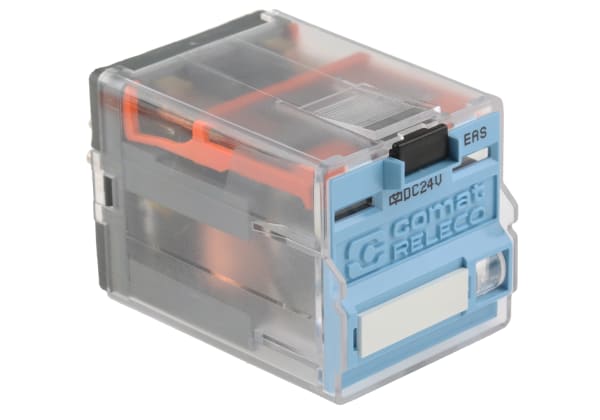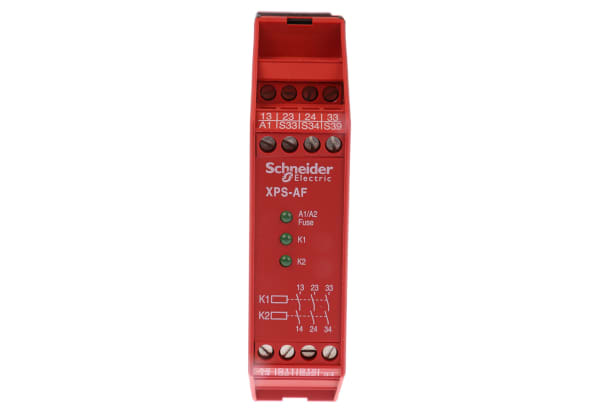- Published 6 Oct 2023
- Last Modified 6 Oct 2023
- 6 min
Different Types of Electrical Relays
Discover the world of electrical relays and gain insights into distinct types designed for diverse industrial applications.

Reviewed by Stephen Bettles, Technical Support Engineer (September 2023)
This guide will explore the concept, history, and different types of electrical relays. It will equip you with the knowledge to make informed decisions when selecting relays for specific applications.
What are Electrical Relays?
Electrical relays are essential components of many industrial and commercial systems. These electrically actuated switches control higher-power electrical output circuits using low-power input signals. This fundamental principle makes them indispensable for tasks ranging from turning on lights to safeguarding complex machinery.
History of Electrical Relays
Relays date back to the early 19th century when they were used in telegraph systems to amplify weak signals. As technology evolved, so did relay applications. The discovery of electromagnetism paved the way for the development of electromagnetic relays, which offered more reliable and efficient control of electrical circuits. With advancements in solid-state electronics, modern relays now provide faster response times and increased reliability. They also encompass a wide array of functionalities, making them indispensable in industries ranging from automotive to telecommunications.
Electrical Relay Types
In this section, we'll explore the different types of electrical relays, each designed to cater to specific industrial needs and applications. Let's delve into the details of each type.
Automotive Relays
Automotive electrical relays are specifically designed for the automotive industry and play an integral role in vehicles.
These relays facilitate control over various electrical components in vehicles, such as headlights, windscreen wipers, and air conditioning systems. With the capacity to seamlessly bridge the gap between low-power control signals and high-power load activation, they translate digital directives into tangible mechanical responses. As a result, relays ensure the safeguarding of delicate control circuitry from high currents inherent in operational functions such as lighting, wiper control, and fan activation.
They withstand harsh engine compartment conditions and ensure critical systems operate seamlessly, adding to vehicle efficiency and performance. The environmental conditions to which these relays are subjected can be challenging, including elevated temperatures and mechanical vibrations within engine compartments. Nonetheless, they are designed for durability and engineered to withstand the stresses associated with this environment.
Force Guided Relays
Force-guided relays are a staple in safety-critical applications where failure can have severe consequences. Engineered with mechanically linked contacts, these relays guarantee dependable switching and prevent simultaneous closure of all circuits. This unique feature makes them suitable for applications where redundancy and fail-safe operation are not just advantageous but mandatory.
Force-guided relays are often used in industries requiring strict compliance with safety standards and regulatory frameworks. Their mechanical linkage ensures a level of fail-safe protection that diminishes vulnerability to potential faults and enables continuous operation, even in the face of unforeseen contingencies.
High Frequency Relays and Radio Frequency Relays
High-frequency (HF) relays and radio frequency (RF) relays are capable of switching higher-frequency signals. They find their niche in applications spanning telecommunications to radar systems and high-frequency testing equipment. In these scenarios, signal control precision becomes paramount.
Electronic devices employ frequencies in a state of continuous escalation, prompting the utilisation of high-frequency relays to facilitate circuit isolation in such environments. These relays are used wherever electronic signals are generated at high frequencies. This encompasses various domains including telecommunications, computers, and industrial machinery.
In telecommunications, where rapid and seamless signal transmission is imperative, high-frequency relays prove their mettle. These relays facilitate efficient signal routing through intricate network architectures, ensuring minimal signal degradation and optimal transmission quality. Their ability to swiftly toggle between different signal paths with the utmost precision makes them indispensable in maintaining telecommunications network integrity.
Specifically tailored for radio applications, RF relays assume a pivotal role. They are frequently employed in testing equipment and radio broadcasting devices. RF relays play an indispensable role in enabling distinct circuit systems that facilitate transmission and reception.
Both RF and HF relays are indispensable for managing the high voltages that often accompany high frequencies. This is a challenge conventional relays cannot handle.
Power Relays
Power relays are capable of handling high currents, they frequently switch power-demanding devices like motors, heaters, and lamps, playing a pivotal role in an array of industrial processes and commercial applications.
Reed Relays
Reed relays feature a design centred around two hermetically sealed blades controlled by an electromagnetic coil or magnet. Swift switching times, the ability to handle low-level signals, and a long lifespan characterise these relays. As a result, they are often used in applications requiring minimal signal interference.
The construction of reed relays ensures an airtight, impermeable enclosure. This safeguards the blades from external contaminants and environmental factors, increasing relay reliability and performance.
Signal Relays
A signal relay is a type of electrically operated mechanical switch. These devices serve as pivotal components in various industrial applications, where their core function revolves around the controlled opening and closing of circuits.
Categorised into two distinct types, latching and non-latching relays, signal relays are tailored to suit a range of operational requirements. Latching relays cycle between two stable positions via a set and reset control input, whereas non-latching relays revert to their default position once electrical input ceases.
Signal relays are often used on printed circuit boards (PCBs) for handling switching tasks. Specifically designed to handle low currents and voltages, these relays prove invaluable in situations demanding precision and efficiency. Their operational capacity extends to up to 2A switching, making them well-suited to tasks involving controlled current modulation.
Solid State Interface Relays
Solid state interface relays are an alternative to other relay types with conventional electromechanical contacts. Offering a range of advantages, these relays boast high-speed switching capabilities, prolonged operational lifespans, and a lack of moving parts to wear out over time.
Solid state interface relays differ by eliminating moving parts altogether. Instead, they harness solid-state semiconductors' electrical and optical characteristics to perform input-to-output isolation and seamless switching.
These relays are often used between control systems and high-power loads. Their versatility, compact form, and cost-effectiveness ensure that they can be found in many industrial applications such as motion control, power distribution, heating systems, and lighting management.
Timer Relays
Time plays a crucial role in many industrial processes. Timer relays are essentially control relays that provide time-delayed switching, useful in applications that require sequential actions or delayed start/stop functions. They are often used to orchestrate complex sequences with precision.
These relays combine electromechanical output relays with control circuits. Contacts can be opened or closed before or after a preset interval. It is possible for relays to be normally open or normally closed and to delay timed functions from just a few milliseconds up to hours or even days.
Timer relays play a critical role in streamlining processes by introducing measured time intervals between actions. This affords industries the capacity to achieve a finely tuned sequence of events, optimising efficiency, safety, and accuracy. Timer relays are widely used in industries ranging from manufacturing and automation to energy and lighting.
Summary
Many industrial applications rely on electrical relays for switching and circuit control. From the automotive sector to safety-critical systems, each relay type brings a distinct set of features and advantages, tailored to meet specific requirements.
In the dynamic world of electrical relays, you must equip yourself with the tools you need to ensure not only the efficiency, safety, and reliability of your systems but also the seamless integration of technological advancements.



